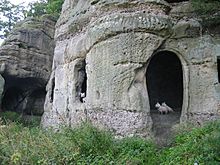Anchor Church facts for kids
Quick facts for kids Anchor Church |
|
|---|---|

Anchor Church near Ingleby
|
|
| Location | Ingleby, Derbyshire, England |
| Geology | Keuper sandstone |
|
Listed Building – Grade II
|
|
| Official name: Anchor Church | |
| Designated: | 9 January 1967 |
| Reference #: | 1096534 |
Anchor Church is a cool set of caves found in a rock near the village of Ingleby, Derbyshire, England. These caves are made from a type of rock called Keuper Sandstone. Over time, people have made these caves bigger. They even added holes for doors and windows, turning them into a simple home!
Long ago, this sandstone rock was right next to the River Trent. The river's strong currents helped to carve out these caves. Now, the river has changed its path. The caves open up to a quiet pool of water instead. This spot is special for its geology and wildlife.
Contents
History of Anchor Church Caves
The name "Anchor Church" comes from the word anchorite. An anchorite was a religious person who chose to live alone. They would withdraw from the world to pray and live a simple life. People believe that a hermit named St Hardulph lived here in the 6th and 7th centuries. He spent his time praying in these very caves. A nearby church is even named after him.
Later, in the Middle Ages, a monk named Bernard also used these caves. He lived here to make up for something he had done wrong. We know about the caves from old church records dating back to 1658.
Around 1715, a writer named William Woolley described the caves. He said they were like a chapel dug out of rock. He mentioned that tradition said it was a hermit's cell. He also called it a "solitary, pleasant place." In 1811, D P Davies wrote about the caves too. He noted that the different rooms inside made it seem likely a hermit lived there. This is how it got its name, Anchor Church.
The caves were even featured in a painting. Thomas Smith of Derby painted them in 1745.
How the Caves Were Changed
In the 1700s, the Burdett family, who lived at Foremarke Hall, made the caves larger. They added a door in 1845 and some brickwork. They even built steps to the main entrance. Sir Francis Burdett used the caves as a summerhouse. He would often have picnics there with his guests.
The caves were an important part of the beautiful landscape around Formarke Hall. Owners and guests would walk to the caves. They enjoyed the views over the Trent valley. Today, Anchor Church is a popular stop for people on walks in the area. It is also a protected historical building.
The area around Anchor Church is important. In 2015, there was a plan to dig for gravel nearby. This showed how valuable the landscape is.
Nature Around Anchor Church
Anchor Church is recognized for its important geology. It is also a special place for local wildlife.
Plants and Animals You Might See
You can find interesting plants growing on the rocks. One is called wall pennywort. In the quiet water channel below the rocks, you might spot shining pondweed. This plant is very rare in Derbyshire.
Other animals have been seen near Anchor Church too. These include the Eurasian otter. In the 1970s, small water-pepper plants were also recorded here.



